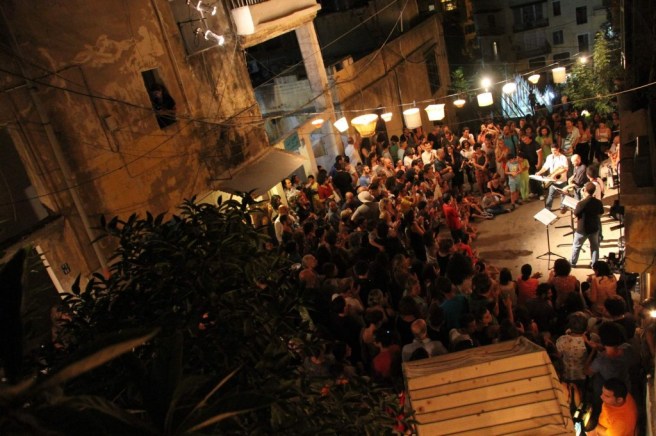post 276/365

To eternally perform, to create a role, practicing the dreams of a life, is a talent that they share with their public. Revolutionary works, purposefulness, in that moment the viewer and the artists are entwined. Their realty in the grasp of the setting, the performers drift between reality and fiction. Their courage floods in waves as the artists voice powers underneath opaque blue skies. Light dangling from one building to the other in between broken down stairs and rooftops overlooking the sea. On this night we are all but one, rich, poor, young, and old. We are humans existing in a realm created by this wondrous group of artists taking us on an unusual journey through the passageways of the neighborhood.
Collective Kahraba, founded by Aurélien Zouki, Rima Maroun, Camille Aoun, and Eric Deniaud, is a performing arts company comprised of artists and technicians from different backgrounds. They firmly believe that art is a trajectory towards openness and dialogue between various communities and regions of Lebanon, as well as developing international exchange and partnership.
They create shared moments of togetherness and reverie, where everyone feels welcome to share dreams, joy and humor through stories brought to life through the actors and spectators by bringing performances to areas that never had access to cultural activities, making it free of charge to ensure accessibility to the largest number of people.
They also organize cultural interventions in different public space and in different social realities where culture could play a role of change and development (refugee camps, prisons, hospitals…) in order to foster imagination, critical thinking and curiosity, and raise public responsibility in the building process of a culture of peace.
The free three-day outdoor festival they have created, Nehna wel Amar wel Jiran (The moon, the neighbours and us), which they started in August of 2011, on the Vendome staircase offer theatre, dance, puppetry, storytelling and music in a Beirut neighborhood. Taking the form of a guided tour, small happenings occur throughout the evening, unfolding a story that culminates in a highlighted event. By doing so, the quartier becomes a welcoming space animated by encounters, interactions and collaborations between neighbors, guests, amateurs, professionals, artists, children and adults alike.
The location is also a symbolic and poignant place. The neighborhood used to be home to the Vendome Cinema (the oldest movie theater in Achrafieh), a landmark of Beirut’s cultural heritage, torn down in 2011 to make space for the 30-story AYA tower, currently under construction. The cinema is only one of Beirut’s many artistic and cultural hotspots that have fallen victim to real estate agents. The sweeping wave of demolition and privatization is making access to cultural spaces unaffordable to performers as well as a large share of the population.
On the stairway, nothing has changed though. The stairs are like a village inside the city, where neighbors come together, whether in joy or grief. From the rooftop of these old building Beirut’s seaport is still visible.
They aim to highlight young Lebanese committed artists that have few opportunities to present their work, and even less to collaborate together. From Visual Arts to Theatre performances, Puppet making, Festival creation, they do it with their bare hands and the help of friends and a growing group of passionate artists, attracting local and international artists to perform their work in public spaces falling prey to Lebanon’s real estate developer
Amid these daunting changes, they are making a point of bringing art back to the people. Because they believe that it is important to offer quality performances for free, to share moments of beauty within family, to acknowledge that art and culture are two necessary ingredients for human dignity and the construction of our societies. So for three nights, stairs, balconies, windows, rooftops, and gardens become their stage. Food is served by the neighborhood cooks, which brings a certain conviviality to the evenings, generating links between people that wouldn’t have met otherwise.
“In these three days of the festival we live the utopia of a world where art is for everyone and people from all walks of life come together with no economic, religious or cultural divides,” says Aurélien Zouki
Performances take place amid the sounds of the city, still bustling with life as the spectators are plunged into a different reality. Passers-by stop to join the show, taken aback by the sudden appearance of art beyond its designated setting, while a few heads appear on the overlooking balconies. By offering free, open-air performances, the festival succeeds in breaking those economic and social barriers that have made Beirut’s arts scene inaccessible to many. Storytelling has the power to bridge the gap between different cultures.
International curators, directors and producers have also come to Beirut to take part in the encounters organized by the Kahraba Collective to promote Lebanese talent and create a fertile ground for international collaboration.
Nehna Wel Amar Wel Jiran also plays a role in revitalizing public space in Beirut. Public parks are almost extinct. Stairs and alleys connecting the traditional quarters of the city may be the only public spaces that do not fall under the jurisdiction of the municipality or the state.
Watching people perform their art among their community is my favorite thing. This sharp inhale… Breathing the words… Exhaling art… Their hands fly around the space grabbing thoughts and pulling them together. Their body moves to the rhythm they speak. Seeing and hearing storytellers recount past and present tales of small communities is a gift that Collectif Kahraba has managed to bring to their public.
To my Beirut and all those who love her…






















